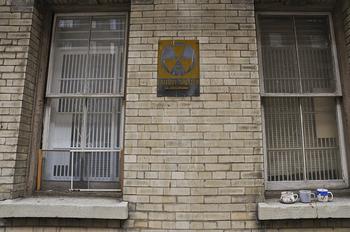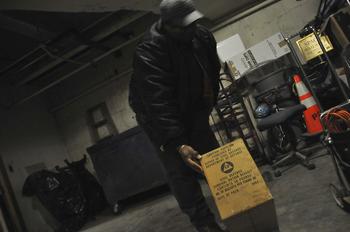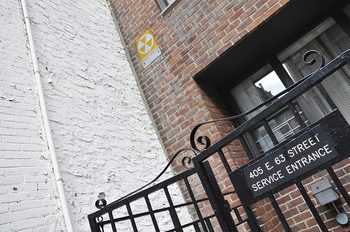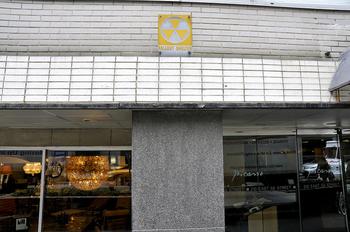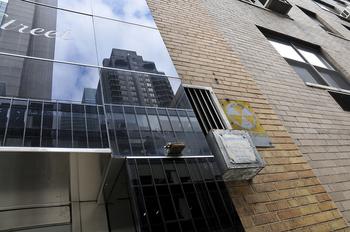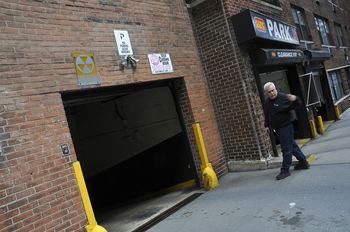Most people who walk by 130 West 16th Street in Chelsea never notice the faded Fallout Shelter sign on the red-brick apartment building. And if they do, they rarely know what it’s for.
Lawrence Salemme is an exception. The 59-year-old artist grew up here and played in the fallout shelter as a boy.
"We played all the games, street games, that kids played — hide n’ seek, ringolario — all of them," Salemme said.
Cold War-era signs for nuclear fallout shelters still mark buildings across the region – generating question marks among many people under age 40 and curiosity, nostalgia, or knowing smirks for those a little older.
With news coming in from Japan, people might wonder: would the fallout shelters do anything for people if there was a meltdown at Indian Point?
Civil Defense officials in the 1950s and '60s designated hundreds of thousands of sites across the country as shelters. They were basement areas of schools and other large buildings, stocked with water and canned food – and they were considered a crucial way of limiting the damage posed by nuclear war.
Shelters – both those in public buildings and in people's backyards – became a staple of civil defense drills, public service announcements, articles in Life magazine and Popular Mechanics and even the occasional pop song.
Black-and-yellow signs are still outside many buildings, but the shelters are no longer active. It's not clear exactly when the federal fallout shelter program began and ended. The agency that sponsored it was formally terminated in 1979.
Kelly McKinney, Deputy Commissioner for Planning and Preparedness at the city's Office of Emergency Management said "shelter" for a radiation event now is defined broadly – and can be under-ground or above-ground.
"The advice would be to go inside, as deep inside a building as you can, and stay there because shielding is one of the primary means of protection," McKinney said.
That's the guidance for responding to a terrorist dirty bomb, or what emergency planners call an "improvised nuclear device." The fallout shelters would probably do better in such a situation than the one they were designed for historically, said Dr. Irwin Redlener, head of Columbia University's National Center for Disaster Preparedness.
"Those shelters were in good locations, and if they were available now, they would be places where they would be useful. On the other hand, they’re now being used for other purposes," Redlener said. "The stocks of food are long gone. Sometimes there's a sign on a building, and there's not really a shelter there anymore. Ironically, we may have been able to use shelters now more than we would have during the Cold War."
He said they wouldn't likely have helped much against the large-scale devastation pictured in a thermonuclear war, unless they were very far from the broad swathe of the metropolitan area that would have been targeted.
For a major nuclear reactor meltdown, the response is less clear-cut.
McKinney said sheltering generally wouldn’t come into play. He said there would be enough time to evaluate how the wind was carrying any radioactive cloud and enough time to devise and disseminate plans.
"Typically, you have a lot of advance warning about the water heating up," he said. "So, in that case, our advice, typically would be to move. We would be moving people out and we have plans in place to move out specific neighborhoods, if that were necessary."
Federal authorities are telling Americans in Japan to stay more than 50 miles away from the Fukushima Daiichi reactors.
A 50-mile radius from Indian Point includes almost all of New York City and most of the surrounding counties, with a combined population close to 20 million people.
McKinney said he does not envision a massive five-borough evacuation – but that more study of evacuation plans is needed.
Redlener said the issue remains how long fallout lingers. Many radioactive isotopes decay and largely disappear quickly. But others linger indefinitely.
Although Redlener is a long-time critic of local, state and federal governments — all of whom, he said, fail to prepare residents for a range of possible catastrophes — he said if people do nothing else, they would do well to familiarize themselves with some of the information available online from reliable sources, such as FEMA.

